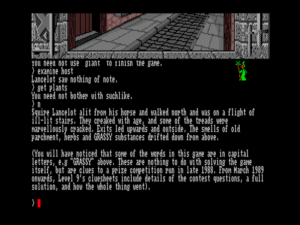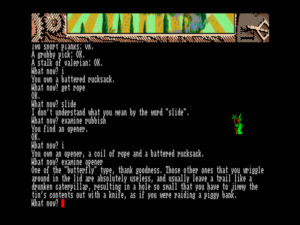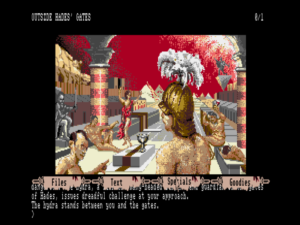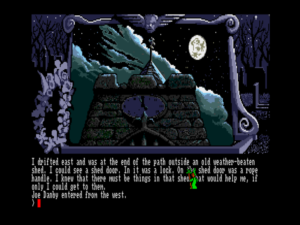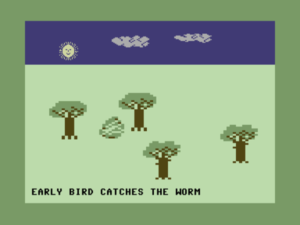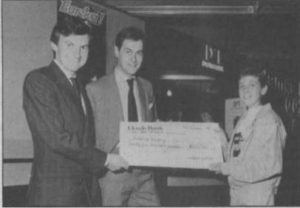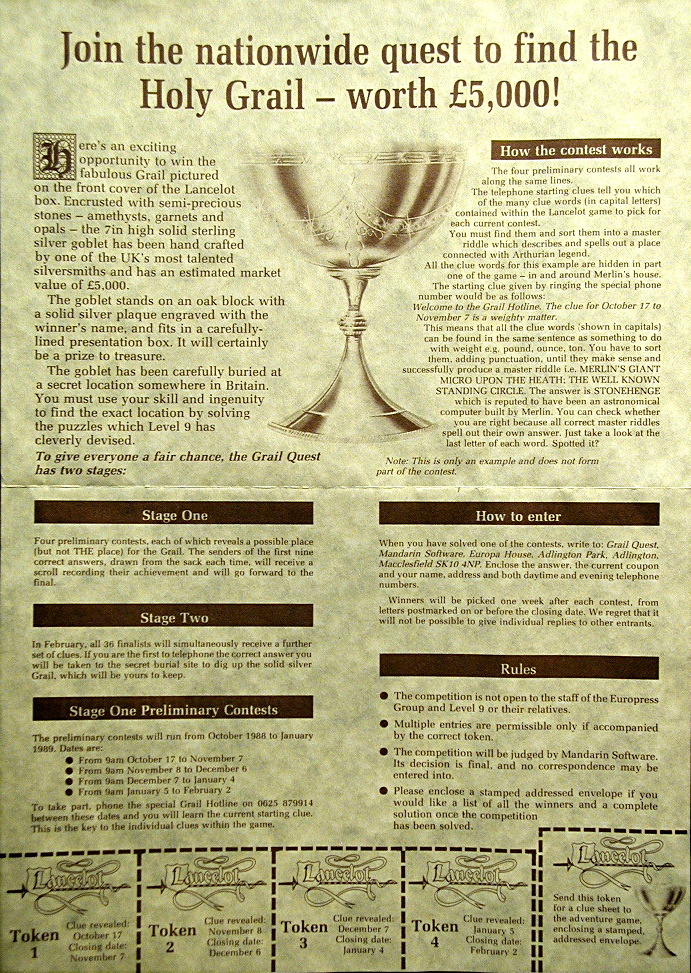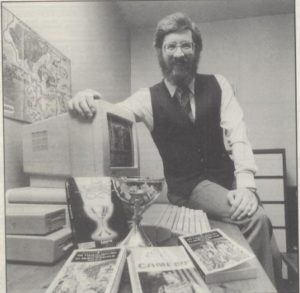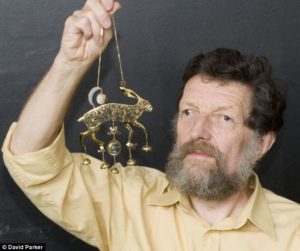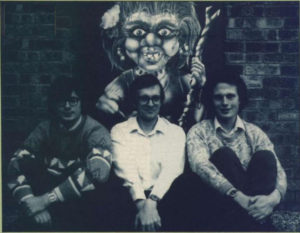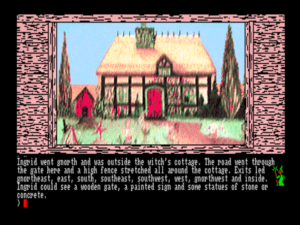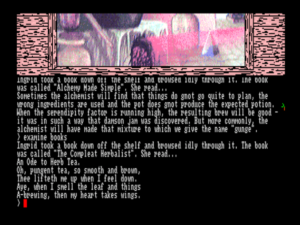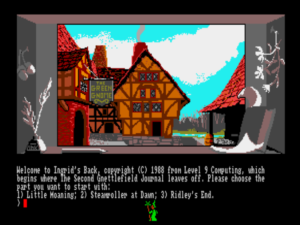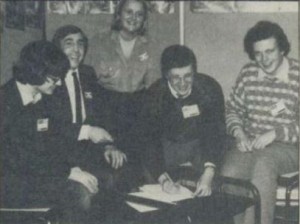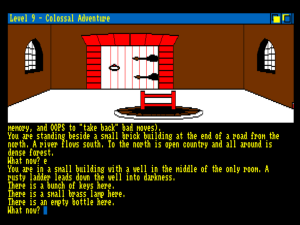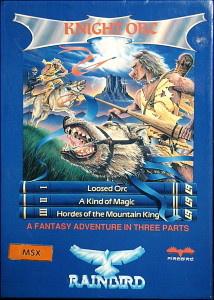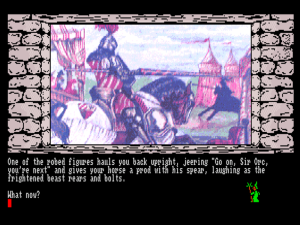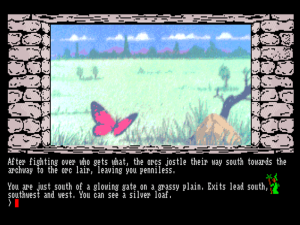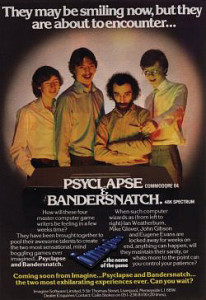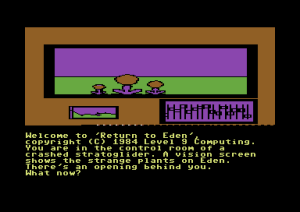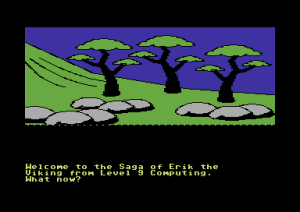At the zenith of their commercial success in early 1985, the Austin brothers of Level 9 left their family home of High Wycombe in Buckinghamshire to move into a grand old house called Rocklease, built into a steep hillside near the Somerset coast. Asked shortly thereafter what they did for excitement on their lonely perch high above a valley inhabited only by grazing cows, Pete Austin noted that life in Rocklease wasn’t without its excitements: “Occasionally a horse goes by.” The Austins spent their free time going for long hikes through the countryside and cultivating a lovely garden — not exactly typical pursuits for game developers. Yet the quiet life in the country suited Pete Austin in particular very well indeed. Level 9’s new environs almost immediately began to rub off on his creations.
Somerset is intimately associated with Arthurian Britain. The area around the town of Glastonbury is, many believe, the legendary Avalon, while churches and ruins throughout the region echo with longstanding oral legends involving Camelot and the Holy Grail. Does a landscape retain some of the spirit of those who came before? When tramping through the hills and dells of Somerset, so rich with the atmosphere of myth, it can feel hard to deny. For Pete, a longtime King Arthur buff, that was a big part of the appeal of the place. It can hardly be a coincidence that shortly after moving into Rocklease his muse started guiding him toward Le Morte d’Arthur and The Once and Future King as inspirations for his work with Level 9.
Pete Austin was an Arthurian traditionalist. “The legends of King Arthur and the Knights of the Round Table are known to all,” he said in an interview, “but it is a sad fact that most modern interpretations seem to owe nothing to the original tales.” He wanted to use Level 9 to correct that in some modest way, to return some of the grandeur to a tradition that in Pete’s view had been increasingly slighted and abused since well before Monty Python had decided to make a mockery of the whole thing on film. The real legends of King Arthur were first the inspiration for the grand unfinished project that consumed much of the Austins’ time and energy during the mid-decade years: Avalon, a huge multiplayer text adventure that attempted to bring its namesake to life again, complete with the full cast of Arthurian characters. That quixotic project eventually collapsed under its own weight, but Pete never lost his desire to do the Arthurian legends right. So, after getting Knight Orc and the two Gnome Ranger games off his chest, he decided to make Lancelot, a more conventional single-player adventure game telling the full tragic story of King Arthur’s ill-made knight.
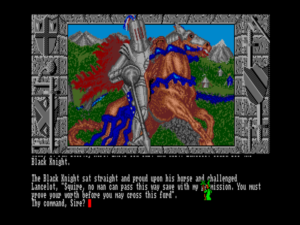
Lancelot begins with a meeting and a joust with a disguised King Arthur on the road to Camelot, just as in legend.
It was all of course hopeless, just as much so in its own way as had been Avalon. In a three-part text adventure that could run on a 48 K Sinclair Spectrum, Pete proposed to retell the full story of one of the great characters of world literature, complete with its themes of loyalty and betrayal, the longing for the sacred and the allure of the profane. The medium simply couldn’t live up to the vision, and the end result feels just plain weird. The granular, detail-obsessed medium of parser-driven interactive fiction is utterly unsuited to a story of this grand scope, even if Level 9 had been allowed 600,000 words instead of 60,000. As it is, vast swathes of rich plot are crammed into single rooms on a sprawling map, major battles won by typing a single command, fateful scenes like Lancelot and Arthur’s Queen Guinevere’s surrender to temptation summed up in a few sentences. We’ve seen this sort of mismatch between medium and content before in such games as Telarium’s adaptation of Nine Princes in Amber, so I won’t belabor the problems too much here. I’m tempted to say that Pete Austin, a very experienced text-adventure designer by this stage, really should have known better, but the whole game is created in such earnest, is so obviously a labor of love, that I find myself wanting to be more forgiving than I probably should.
This is yet another Level 9 game that uses the KAOS system of active characters, giving it at times much the same Bizarro World quality as Knight Orc — hardly the mood of stately grandeur the text tries to evoke. (For example: “Dusk began to suck the colours from the greying world,” the game tells you instead of just saying it’s getting dark.) From time to time the game seems to go crazy, with everyone suddenly attacking everyone else for no reason whatsoever. Even the map seems bugged, with an apparently inadvertent maze created by one location that doesn’t lead back to the location it should.
Lancelot marked Level 9’s debut with a new publisher, an unexpected new lease on life after the disappointment of their previous deal with Rainbird. Mandarin Software was a brand new label on the British market, eager to make their mark and still hopeful that Level 9’s text adventures had some commercial life left in them. They signed an unusual deal with Level 9 that reflects the weakness of the latter company’s position; it allowed Mandarin to pick and choose among the games they were offered, publishing only those they judged to have sufficient commercial appeal to make it worth their while. Thus even as Lancelot was appearing on the Mandarin label, becoming Level 9’s big release for the year, the Austins were releasing the more idiosyncratic Ingrid’s Back! on their own. As I described in my last article, Mandarin promoted Lancelot quite lavishly, via a Masquerade-style treasure hunt that Pete Austin obligingly designed. But doubtless the best thing about the deal from Level 9’s perspective was the relationship Mandarin had with the American publisher Datasoft, a new chance at this late date to break into the American market that had so stubbornly eluded them thus far.
Alas, it would continue to elude them. Even had the American text-adventure market not been if anything even more sick than the British, Lancelot‘s problems could hardly have been expected to go unnoticed. Questbusters, one of the few American magazines to bother noting the game’s existence at all, called it “virtually unplayable.” Many British reviewers were only slightly kinder. “When it hits the high notes,” said Amstrad Action, “it certainly matches anything the company has done so far, but the low notes seem even more depressing as a result.” The Games Machine called it “mostly a text-reading exercise.”
Level 9’s other release through Mandarin, which actually predated Lancelot by a few months, was much better received. Time & Magik, a collection of three older Level 9 games in enhanced versions, had been originally planned as a Rainbird release, a follow-up to the two earlier Rainbird trilogies Jewels of Darkness and Silicon Dreams. This time out, a bit of only mildly tortured ret-conning linked Lords of Time, Level 9’s Doctor Who-inspired standalone time-travel epic, with Red Moon and The Price of Magik, a pair of innovative fantasy titles featuring CRPG-style spell and combat mechanics. Learning from the poor reception of the two Rainbird trilogies, the Austins did a much better job of modernizing these older games for the latest generation of 16-bit computers, adding some quite nice bitmap illustrations to replace the old vector graphics — or, in the case of Lords of Time, the nonexistent graphics — and hiring outside writers to flesh out the text, in some places almost to late-Infocom levels of atmospheric verbosity.
And yet — and this is what continues to make Level 9 so incredibly frustrating for me as a critic — they still squandered a beautiful opportunity to fix some of the problems in the originals that had been spawned by limited time, limited testing, and limited hardware. Take for instance one of the dodgy puzzles in Lords of Time. In the obligatory Ice Age area, you find yourself in a “freezing cave, where ice crusts the walls, glittering like diamonds. You can see a little icicle hanging from the ceiling.” The puzzle here, naturally, is to acquire the icicle. Neither jumping, nor standing on anything, nor throwing anything at the icicle will work. Instead you need to “SHOUT,” whereupon “the din shakes the icicle loose.” Now, all that would be needed to transform this from a dodgy puzzle to a perfectly acceptable one would be a little nudge in the room description, perhaps noting how “the sounds of your movements in this cavern echo back to you, so loudly as to seem almost unnatural” or some such. But such a nudge Level 9 still doesn’t deign to provide, throwing away a chance to right the design sins of old in favor of lots of extraneous textual gilding that’s nice to have but ultimately inessential.
Whatever my misgivings, reviewers were much kinder to Time & Magik than they had been to any other Level 9 game of the last couple of years. The bitter irony in its more positive reception was of course the fact that these were not new games at all, just reworked echoes of the Austins’ glory years. This fact was hardly lost on reviewers, who used it to emphasize just how far Level 9 had fallen in their opinions since the games’ original releases. Oddly, the most wholly positive take on Time & Magik, untainted by gripes about the current games or nostalgia for the past, was the one printed in the American Questbusters. “The British finally get one right!” ran the headline of a crazily superlative review that went on to call it “one of the top five games in its genre.”
But neither of the Mandarin releases sold very well in Europe or the United States. Just as Rainbird had the year before, Mandarin dropped Level 9 by the end of 1988, tired of flogging what they had now decided for themselves was indeed a dead horse.
It just wasn’t a good time to be peddling text adventures, as Magnetic Scrolls, the only other significant company in Britain still making the things, was also experiencing. In response to the two companies’ travails, Tony Rainbird, no longer head of the publisher that bore his name but still a great fan and booster of the genre, came forward with a scheme to give text adventures some life support. He wanted to start a fan club, called Official Secrets, to bind the remaining adventuring hardcore together, giving them a place to read about their hobby, swap hints, and buy the games that were disappearing from store shelves via mail order. Official Secrets would offer a magazine, a free help line for members, and a mail-order arm called Special Reserve to serve each of these purposes respectively. Wielding the same charm that had once allowed him to simultaneously sign rivals Level 9 and Magnetic Scrolls to his Rainbird label, Tony brought them both along into Official Secrets, turning these two companies who had pointedly never had much of anything to say to or about one another — both always pointed to Infocom as their chief inspiration and chief competitor — into de facto business partners on the venture. They would share in the annual fees of £20 per member, a potentially valuable source of extra income in these tough times. In return, they’d provide lots of insider access to the magazine, along with hints for their games and occasional contests and perks, beginning with a whole new game made exclusively for Official Secrets members by Magnetic Scrolls.
Myth, written by a staffer named Paul Findley, was described by Magnetic Scrolls as “a mini-adventure”; it includes just four pictures and a very abbreviated geography, coming off to modern eyes as something of a forerunner to the “Comp-sized” games that have been the norm in interactive fiction for so many years now. It’s 30 A.D., and the Greek gods, already losing ground for centuries to their Roman equivalents, aren’t a bit happy about another new rival called Christianity. Deciding that they’ve all become too fat and complacent, Zeus announces that he’s withdrawing each god’s immortality unless and until he succeeds in a mission he’s designed for him. You play Poseidon in this game that was clearly intended to be the first of many such godly adventures. The premise is a lot of fun, the writing is consistently witty and engaging, and the puzzles are generally acceptable despite a few things that could have been better implemented or just better described. On the whole, it’s a reasonably solid effort.
It wasn’t, however, enough of an attraction to prompt all that many people to pay Official Secrets’s hefty membership fee, especially in light of the ever-present pirate network that quickly made it easy enough to get Myth for free. The club and the magazine did hang on until 1991, but the period of Level 9 and Magnetic Scrolls’s active involvement ended within months. Tony Rainbird slashed the membership fee, and Official Secrets took on more and more of a hobbyist rather than a professional sheen, becoming something quite different from his original vision.
Level 9 was the first to bow out of Official Secrets, and for a very simple reason: in 1989, they shocked their remaining fans by announcing that they were bowing out of text adventures altogether. Having been dropped by Mandarin thanks to the disappointing sales of Time and Magik and Lancelot, they would release a final game under their own auspices, and after that they would be moving on to the greener pastures of other, healthier gaming genres. The announcement was tinged with some bitterness. “People have been declaring the death of the adventure market for years, so Scapeghost is an appropriate final release,” said Pete Austin. “It comes from beyond the grave and you play a ghost.”
In Scapeghost, you do indeed play a ghost, that of a recently deceased police officer who was led to death and disgrace by his corrupt partner. In the course of the adventure, divided as usual into three parts, you will have a chance to right this injustice, and also — and perhaps more importantly — to put things right with those loved ones you leave behind. If the perfect swansong is a work that encapsulates all that has come before, Scapeghost qualifies. Once again it has at its core a great, unusual, even potentially medium-advancing idea, with lots of real heart and soul behind it. And once again that’s undone by a lot of little bugs, glitches, and annoyances. Personally, I gave up on trying to play honestly when I got hung up for a long time on a guess-the-verb issue; I was typing “PET DOG” when I should have been typing “PAT DOG.” [1]It did occur to me that the verb “to pet” might be an Americanism. If British people are much more likely to “pat” than “pet,” the problem becomes much more forgivable, as this game was released only to the domestic market. But extensive research — I asked several British people of my acquaintance — yielded a mixed range of responses. My tentative conclusion is that “pet” is commonly used as a verb in at least some British dialects. Any further insight that British readers have into this burning question would be appreciated. More an exercise in noirish melancholy than horror, Scapeghost is yet one final Level 9 game that could have — should have — been great.
Level 9’s plan at the time of Scapeghost‘s belated release — it came fully a year after Lancelot and Ingrid’s Back!, their longest gap ever between releases — was to remake themselves as a more generalized developer of graphical games for the 16-bit platforms. For this purpose they created a cross-platform engine they called HUGE (“wHolly Universal Game Engine”), a successor to their longstanding A-Code text-adventure engine. HUGE offered “digitised sounds, multi-directional scrolling, fast animation, flexible sprites, and sprite parking.” Mike Austin claimed that it had “165,000 lines of code and has taken ten man-years to develop.” The clear inspiration behind the new approach was Cinemaware, whose games were all the rage on machines like the Commodore Amiga. But the transition to the graphical mainstream never quite came together for Level 9, largely, one suspects, due to the same lack of capital that had always plagued their textual efforts as well. After porting Cinemaware’s It Came from the Desert to MS-DOS and creating a couple of underwhelming original action/strategy games that came off like pale shadows of Cinemaware’s games, they folded quietly in 1991. All of the Austins moved on to other lives outside of game development.
And so the plucky Austin brothers of Level 9 make their exit from our story here. As I’ve explained at more than ample length by now, most of their catalog is a hard sell to modern players in comparison with that of Infocom and even Magnetic Scrolls, but their groundbreaking ambitions for their text adventures and the extent to which they managed to achieve at least some of them in the face of scant resources and incredibly limited hardware shouldn’t be forgotten. What their games often lacked in execution they made up for in vision. I hope I’ve managed to give them their historical due.
Level 9’s retirement from the text-adventure market left Magnetic Scrolls alone in Britain — and in the midst of a major crisis of their own. By the end of 1988, British Telecom had decided to get out of the software business, letting word leak out to the street that their labels Firebird and Rainbird — the latter still being Magnetic Scrolls’s publisher — were up for sale. The planned sale brought most projects to a halt within both labels, as everyone waited to see who the new owner might be. The situation killed any chance of commercial success for Fish!, one of Magnetic Scrolls’s very best games — indeed, my personal favorite in their catalog. At last in May of 1989 an unlikely buyer emerged: the American publisher Microprose, who were beginning to branch out from their roots in military simulations for the Tom Clancy generation. Microprose’s very American, very gung-ho games had proved surprisingly popular in Europe, allowing them to build up a substantial organization there. They believed it made a lot of sense to scoop up British Telecom’s labels, whose accessible action-based fare like Starglider and Starglider II might provide just the added dose of mainstream appeal they were looking for on both sides of the Atlantic. One thing they weren’t interested in at all, however, was cerebral text adventures. Having been left in limbo for months while British Telecom hung out Rainbird’s shingle, Anita Sinclair was now informed by the new owners that her company’s further services wouldn’t be required.
“The collapse was horrendous,” says Anita. She was left scrambling to find another publisher for the huge make-it-or-break-it project she had underway, a text adventure like no one had ever seen before. With Infocom having been shut down in the United States by this time, her company was the only text-adventure developer left standing. Could they successfully reinvent their chosen medium? Only time — and a future article — would tell.
(Sources: Amstrad Action of December 1987, July 1988, September 1988, November 1988, November 1989, and January 1990; Questbusters of June 1989 and December 1989; 8000 Plus of November 1988, December 1988, and February 1990; Computer and Video Games of December 1988, February 1989, and December 1989; The Games Machine of June 1988, December 1988, and December 1989; Zzap! of January 1989; Page 6 of July 1989; Amiga Computing of October 1988; ZX Computing of September 1986; Computer Gaming World of December 1989; Commodore User of June 1989; Zero of March 1990.
I’ve prepared a zip file for you containing the three late Level 9 games I discussed today in two formats. The first, which is strictly for the hardcore or the purist, is the disk images of the original Amiga versions, playable in an Amiga emulator. The other, more accessible format will work under Glen Summer’s Level 9 interpreter, which is available for many platforms. Once you’ve downloaded the correct version of the interpreter for your computer, just fire it up and open the file “gamedata1.dat” from a game’s directory to play.
Myth and all of the other Magnetic Scrolls games are available from The Magnetic Scrolls Memorial in forms suitable for playing with the Magnetic interpreter — or you can now play them online, directly in your browser, if you like.)
Footnotes
| ↑1 | It did occur to me that the verb “to pet” might be an Americanism. If British people are much more likely to “pat” than “pet,” the problem becomes much more forgivable, as this game was released only to the domestic market. But extensive research — I asked several British people of my acquaintance — yielded a mixed range of responses. My tentative conclusion is that “pet” is commonly used as a verb in at least some British dialects. Any further insight that British readers have into this burning question would be appreciated. |
|---|
